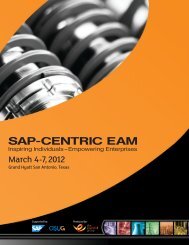March 30 – April 2, 2008 - SAP-Centric EAM
March 30 – April 2, 2008 - SAP-Centric EAM
March 30 – April 2, 2008 - SAP-Centric EAM
Create successful ePaper yourself
Turn your PDF publications into a flip-book with our unique Google optimized e-Paper software.
CONFERENCE DAY 2: TRACK 1<br />
Maintenance Effectiveness<br />
& Reliability<br />
While we are always looking at possibilities to improve planning<br />
& scheduling capabilities, these usually involve a time and money<br />
investment that does not always play out. The functional<br />
approach to using <strong>SAP</strong> for routine maintenance planning and<br />
scheduling requires at a basic level the following: 1) Maintenance<br />
process 2) Maintenance procedures 3) Focused planners 4)<br />
Emphasis on task lists created for repeatable work 5) Scheduled<br />
control of release and schedules 6) Proper schedule update flows.<br />
Lessons:<br />
• Building your base with solid preplans and task lists which<br />
include planning package documents<br />
• Setting up the proper flows of planned work orders and operational/maintenance<br />
priorities for scheduling by using order<br />
status coding, estimation fields, and revision codes<br />
• How to perform weekly and daily scheduling for routine maintenance<br />
with a 1 scheduler to 150+ ratio without any bells and<br />
whistles, just the <strong>SAP</strong> PM module<br />
Original Go-Live Date: October 1998<br />
Current <strong>SAP</strong> Release: 4.6C<br />
1:20 - 2:20 TUESDAY<br />
Scheduling in <strong>SAP</strong><br />
Presenters: Ed Robinson, EMG <strong>–</strong> Midwest Generation<br />
& Gus McIntosh, Vesta Partners<br />
Intermediate<br />
In Q3 of 2007 EMG went live with an <strong>SAP</strong> <strong>EAM</strong> system solution<br />
to support its evolving maintenance/reliability processes. This<br />
was within a broader implementation that included SCM, Fuels<br />
Management, HC and FICO. One of the goals of the <strong>EAM</strong> project<br />
was only using standard functionality to improve existing<br />
work practices laying a solid system foundation to support<br />
future improvement objectives.<br />
Key goals were to utilize <strong>SAP</strong> to further standardize on the weekly<br />
schedule process and provide a basis for continuous improvement<br />
across the seven coal powered generation stations. To meet<br />
these objectives and ensure user adoption the end product had<br />
to be robust, simple to use and allow planners/schedulers to<br />
work more efficiently.<br />
The completed transactional solution combined standard order/<br />
operation list edit functions with capacity leveling/evaluation to<br />
provide the means to prepare, review and communicate the<br />
schedule. Measurement of schedule efficiency and performance<br />
was measured through development of a custom BW report.<br />
Lessons:<br />
• Standard <strong>SAP</strong> Plant Maintenance & Capacity Leveling functions<br />
can deliver an efficient scheduling process<br />
• The set up of Capacity Leveling/Planning Board functions is<br />
complex but with expert knowledge you can quickly implement<br />
and develop the “right” solution<br />
• A custom snap-shot and reporting tool is required to measure<br />
and report on weekly scheduling performance<br />
Original Go-Live Date: July 2007<br />
Current <strong>SAP</strong> Release: ECC 6.0<br />
CONFERENCE DAY 2: TRACK 2<br />
<strong>EAM</strong> Process<br />
Eff iciency Improvement<br />
CONFERENCE DAY 2: TRACK 3<br />
Usability, Access to<br />
Information & ROI<br />
experience<br />
CONFERENCE DAY 2: TRACK 4<br />
Vendor Track<br />
2:<strong>30</strong> - 3:<strong>30</strong> TUESDAY<br />
bOM Teams — An Equipment Commodity,<br />
Reliability Approach<br />
Presenter: Derek Astrike, Dow Corning<br />
Beginner<br />
Bill of Material (BOM) teams are designed to leverage existing<br />
plant systems to improve efficiency, reliability, and maintainability<br />
of segmented equipment commodities. These representatives<br />
make up the teams: stock coordinator, reliability engineers,<br />
tradesmen, and record administrator. The team’s focus<br />
encompasses a wide breadth of facets related to BOMs. Starting<br />
with ensuring asset nomenclature in <strong>SAP</strong> is standardized and<br />
consistent, to defining current stock descriptions. The inventory<br />
strategy is developed taking into consideration the number of<br />
models, criticality, safety stocks, obsolescence, and consignment<br />
options. Using vendor parts lists as a basis, the BOMs are built<br />
and loaded into <strong>SAP</strong>, allowing them to be viewed and printed on<br />
work orders. This information is then used to develop equipment<br />
strategies for the equipment residing in a building.<br />
Lessons:<br />
• Consistency and standardization of the information provides<br />
efficiency gains<br />
• Sharing this information and developing strategies with the<br />
person responsible for the equipment provides a proactive<br />
approach to managing their equipment<br />
• Tradesmen play a key role in ensuring the data integrity of the<br />
BOMs remain once the project is completed<br />
Original Go-Live Date: October 1998<br />
Current <strong>SAP</strong> Release: ECC 5.0<br />
10:05 - 11:05 TUESDAY<br />
CONFERENCE DAY 2 — TRACK 2<br />
<strong>EAM</strong> Process<br />
Eff iciency Improvement<br />
CONFERENCE DAY 2: TRACK 5<br />
<strong>SAP</strong> Track<br />
Leveraging Your Rental Equipment in <strong>SAP</strong><br />
Presenter: Bob Pennington, CITGO Petroleum<br />
Intermediate<br />
Renting equipment for maintenance work orders on a “one off”<br />
basis is not difficult in <strong>SAP</strong>. Leveraging the same piece of rental<br />
equipment across multiple work orders lends to a different challenge.<br />
The cost of rental equipment in a maintenance environment<br />
can be extremely high on a daily basis and can comprise a<br />
large percentage of the overall maintenance budget. These costs<br />
can be somewhat tempered if rentals are leveraged across multiple<br />
work orders, which in turn will promote long term rentals.<br />
The traditional challenge has been how to leverage long term<br />
rentals while being able to track them in a plant and spread the<br />
costs accurately across multiple orders. In this presentation, Bob<br />
Pennington of CITGO Petroleum will enter into a discussion on<br />
how CITGO Petroleum uses <strong>SAP</strong> to manage its rentals.<br />
Continued...<br />
1



